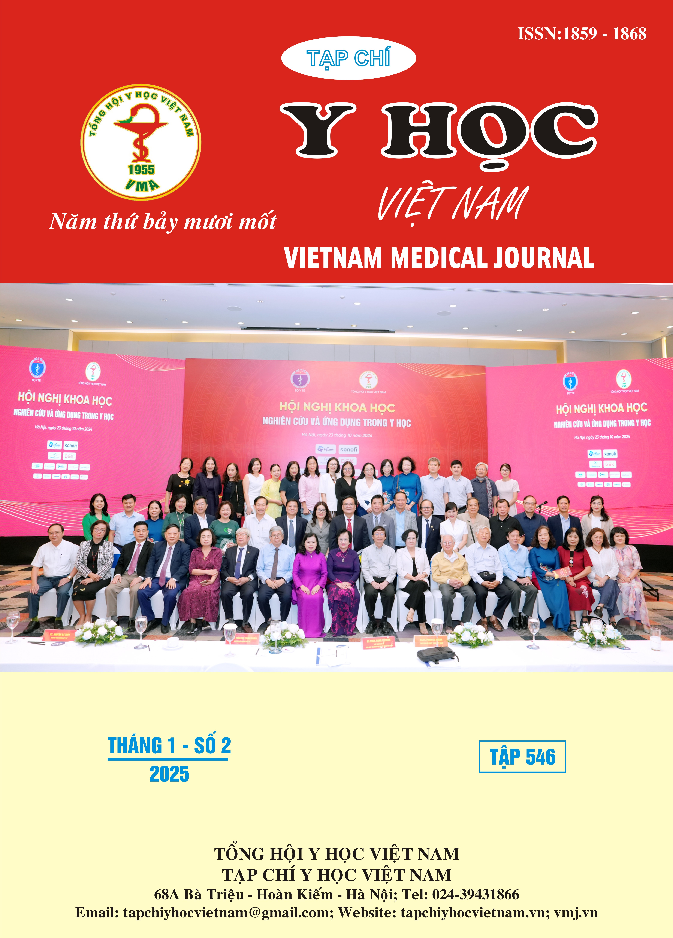OUTCOMES OF ENDOMETRIAL POLYP SURGERY USING THE TRUCLEAR SYSTEM AT THE NATIONAL HOSPITAL OF OBSTETRICS AND GYNECOLOGY
Main Article Content
Abstract
Objective: To evaluate the outcomes of endometrial polyp surgery using the TruClear system at the National Hospital of Obstetrics and Gynecology. Subjects and Methods: A retrospective study was conducted on 148 patients with endometrial polyps who underwent surgery using the TruClear system at the National Hospital of Obstetrics and Gynecology from August 2022 to June 2024. Results: The mean age of the study subjects was 38.4 ± 7.2 years, with most patients aged 30-39 years (41.9%). The primary reason for hospitalization was abnormal uterine bleeding (57.4%), mainly manifested as menorrhagia and metrorrhagia (74%). Diagnosis was primarily based on saline infusion sonography (91.9%) and/or 2D transvaginal ultrasound (93.2%). Most patients had a single polyp (76.4%), and the polyp base was most commonly attached to the posterior wall, anterior wall, fundus, left lateral wall, and right lateral wall of the uterus, in descending order. The surgical success rate was 96.6%, and the complication rate was 2.1%, including bleeding and uterine perforation. Conclusion: The surgical success rate was high, and the complication rate was low.
Article Details
Keywords
endometrial polyp, Morcellator hysteroscopic, TruClear system.
References
2. Raz N, Feinmesser L, Moore O, Haimovich S. Endometrial polyps: diagnosis and treatment options – a review of literature. Minimally Invasive Therapy & Allied Technologies. 2021;30(5):278-287. doi:10.1080/13645706.2021.1948867
3. Vathanan V, Armar NA. A Comparative Observational Study of the Use of Saline Uterine Hydrosonography for the Diagnosis and Assessment of Uterine Cavity Lesions in Women. Int J Reprod Med. 2016;2016:9317194. doi:10.1155/2016/9317194
4. Fadl SA, Sabry AS, Hippe DS, Al-Obaidli A, Yousef RR, Dubinsky TJ. Diagnosing Polyps on Transvaginal Sonography: Is Sonohysterography Always Necessary? Ultrasound Q. 2018;34(4): 272-277. doi:10.1097/RUQ.0000000000000384
5. Ren F, Huang G, Wang X, Li X, Cai J. Comparison of Hysteroscopic Morcellation Versus Resectoscopy in Treatment of Patients with Endometrial Lesions: A Meta-Analysis. Med Sci Monit. 2022; 28:e936771-1-e936771-11. doi:10. 12659/MSM.936771
6. Yin X, Cheng J, Ansari SH, et al. Hysteroscopic tissue removal systems for the treatment of intrauterine pathology: a systematic review and meta-analysis. Facts, Views & Vision in ObGyn. 2018;10(4):207.
7. Tsuchiya A, Komatsu Y, Matsuyama R, Tsuchiya H, Takemura Y, Nishii O. Intraoperative and Postoperative Clinical Evaluation of the Hysteroscopic Morcellator System for Endometrial Polypectomy: A Prospective, Randomized, Single-blind, Parallel Group Comparison Study. Gynecol Minim Invasive Ther. 2018;7(1): 16-21. doi:10.4103/GMIT. GMIT_6_17
8. Wang N, Zhang Y, Liu B. Demographic and Clinical Features of Endometrial Polyps in Patients with Endometriosis. Biomed Res Int. 2016;2016:1460793. doi:10.1155/2016/1460793
9. Khan F, Jamaat S, Al-Jaroudi D. Saline infusion sonohysterography versus hysteroscopy for uterine cavity evaluation. Ann Saudi Med. 2011;31(4): 387-392. doi:10.4103/0256-4947.83213
10. Pampalona JR, Bastos MD, Moreno GM, et al. A comparison of hysteroscopic mechanical tissue removal with bipolar electrical resection for the management of endometrial polyps in an ambulatory care setting: preliminary results. J Minim Invasive Gynecol. 2015;22(3):439-445. doi:10.1016/j.jmig.2014.12.004


